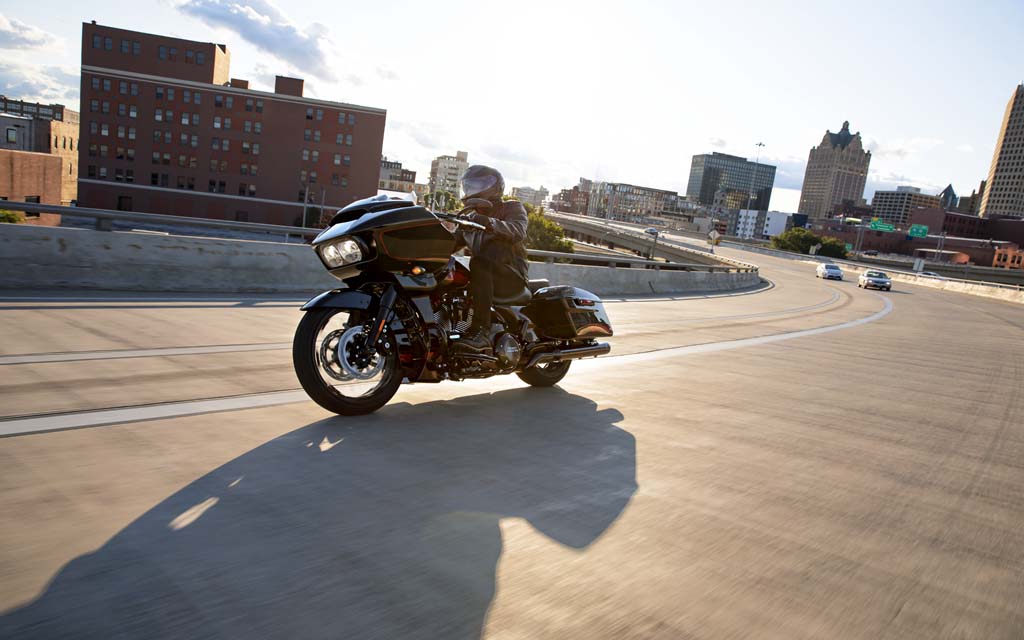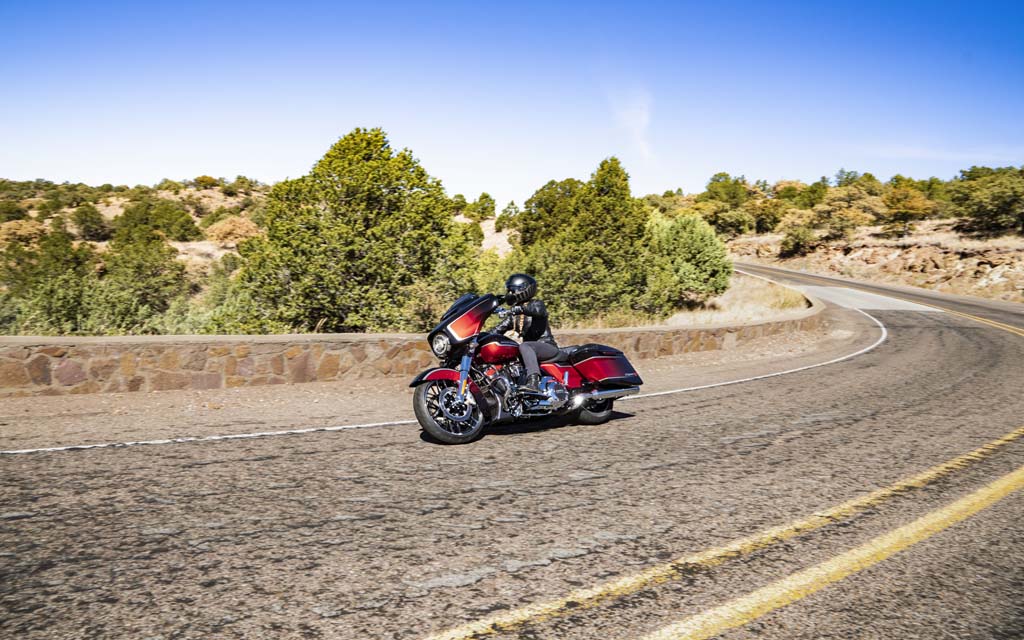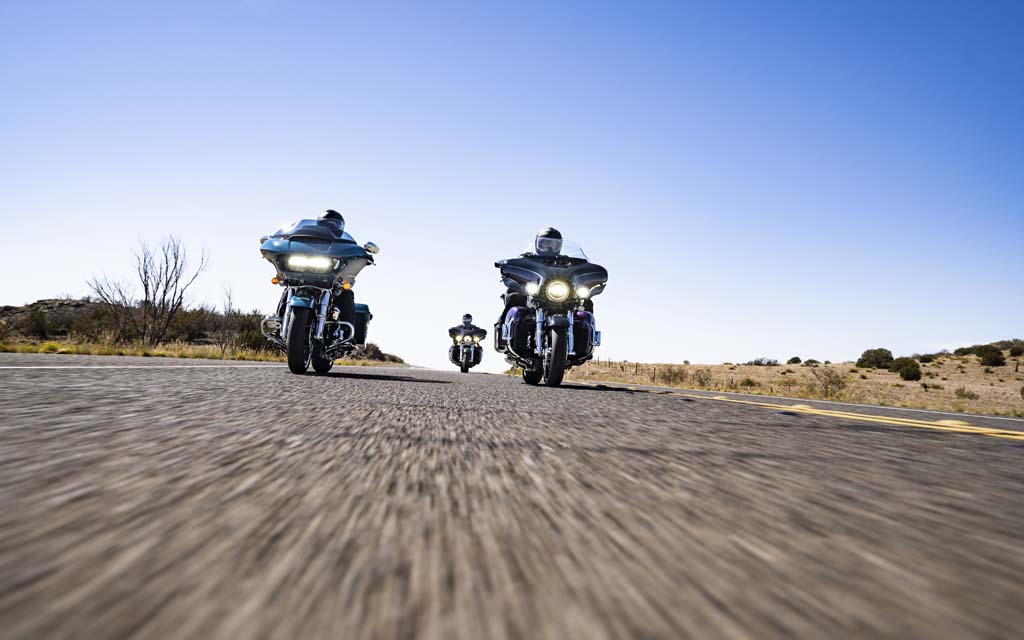Motorcycle-Specific Technology Matches Performance to Available Traction
Harley-Davidson® RDRS Safety Enhancements (formerly known as RDRS) is a collection of technology designed to enhance rider confidence during unexpected situations or poor road conditions. RDRS Safety Enhancements are designed to match motorcycle performance to available traction during acceleration, deceleration and braking, in a straight line or while in a turn. The systems are electronic and utilize the latest chassis control, electronic brake control and powertrain technology.
“RDRS Safety Enhancements are technologies developed by Harley-Davidson and designed to make motorcycling more intuitive,” said VP Marketing Theo Keetell. “Our intent is to assist riders of every skill level in an unanticipated moment when electronic intervention may react more quickly, and with more precision, than our own reflexes can react. A situation that activates an RDRS Safety Enhancement may be rare, but if it occurs, this technology may be invaluable.”
Introduced for many 2020 Harley-Davidson® motorcycles, RDRS Safety Enhancements are standard on all 2021 Harley-Davidson CVO™, Tri Glide® Ultra, Freewheeler®, and LiveWire™ models. RDRS Safety Enhancements are optional on all 2021 Touring models in the U.S. The RDRS Safety Enhancements are bundled together, except where noted.
Important Note: Available traction is determined by the road/tire interface. RDRS Safety Enhancements on motorcycles are only able to adjust brake pressure or powertrain torque in an attempt to keep the forces at the tire from exceeding available grip. These technologies do not have the ability to increase grip, or to intervene when the rider has not made a brake or throttle application (e.g. coasting through a corner with the clutch disengaged). RDRS Safety Enhancements on motorcycles do not have the ability to directly influence vehicle direction. This is a key difference between motorcycle RDRS Safety Enhancements and automotive stability control. The rider is ultimately responsible for speed, steering and path corrections.

Cornering Enhanced RDRS Safety Enhancements
Some RDRS Safety Enhancements may be “cornering enhanced,” technology that is motorcycle-specific and a key difference between RDRS Safety Enhancements and automotive traction/stability control systems. Harley-Davidson motorcycles equipped with RDRS Safety Enhancements have an inertial measurement unit, or IMU, that measures and reports the lean angle of two-wheel motorcycles, or the lateral acceleration of a Trike (three-wheel motorcycle), as it navigates a turn. Because many motorcycles have different size front and rear tires, when the motorcycle leans into a turn the wheels begin to rotate at slightly different speeds. The tire traction patch – the part of the tire actually touching the pavement – also changes as the motorcycle leans in a turn. Cornering enhanced technology takes this into account and for optimal performance intervenes differently when the motorcycle is leaned compared to when the motorcycle is upright.
RDRS Safety Enhancements
Cornering Enhanced Electronic Linked Braking (C-ELB)
This technology applies braking effort to both wheels when the rider uses either the hand lever (front) or foot pedal (rear) brake control, which can help many riders achieve better braking performance. The C-ELB system provides more responsiveness and allows for more balanced front and rear braking under a wide variety of brake applications. The system provides more linking when the rider is applying heavier braking and reduces or eliminates linking for light braking and low speeds. When linked, applying the front brake lever alone will cause the system to also dynamically apply an amount of braking to the rear. Applying the rear brake pedal alone will cause the system to also apply an amount of braking to the left front caliper. C-ELB takes into account the motorcycle lean angle or Trike lateral acceleration. C-ELB will alter the proportioning of brake pressure between the front and rear brakes when braking while cornering in an attempt to improve the ability of the bike to maintain the rider’s intended path.
This technology is standard on all 2020-later CVO™ models and optional on most 2020 Touring models.
Cornering Enhanced Antilock Braking System (C-ABS)
ABS is designed to prevent the wheels from locking under braking and helps the rider maintain control when braking in a straight-line, urgent situation. ABS operates independently on front and rear brakes to keep the wheels rolling and prevent uncontrolled wheel lock. Cornering Enhanced Antilock Braking System (C-ABS) is a variant of ABS that takes into consideration the lean angle of a two-wheel motorcycle, or the lateral acceleration of a Trike model. The brake pressure required to limit wheel slip when cornering is typically lower than the pressure required under straight line operation.
This technology is standard on 2020-later LiveWire™ and CVO™ models and optional on most 2020-later Touring models.

Cornering Enhanced Traction Control System (C-TCS)
The Cornering Enhanced Traction Control System (C-TCS) is designed to prevent the rear wheel from excessive spinning under acceleration when going straight or cornering. C-TCS can improve rider confidence when available traction is compromised by wet weather, a sudden unanticipated change in the surface, or when riding on an unpaved road. The rider may select one of two traction control modes: Standard Mode is optimized for dry surfaces; Rain Mode is optimized for wet surfaces. The system can also be turned off. The action of C-TCS is also tailored when cornering based on lean angle.
This technology is standard on all 2020-later LiveWire® and CVO™ models and optional on most 2020-later Touring models.
Drag-Torque Slip Control System (DSCS)
Cornering Enhanced Drag-Torque Slip Control System (C-DSCS)
Drag-Torque Slip Control (DSCS) is designed to reduce excessive rear-wheel slip under deceleration, which typically occurs when the rider makes an abrupt down-shift gear change or decelerates abruptly on wet or slippery road surfaces. When DSCS detects excessive rear wheel slip under deceleration it will adjust engine torque delivery to better match rear-wheel speed to road speed. On models equipped with C-DSCS the action of DSCS may be tailored when cornering, based on detected lean angle (two-wheel motorcycles) or lateral acceleration (Trike models).
DSCS is standard on all 2020-later CVO models and optional on most 2020-later Touring models. C-DSCS is standard on all 2020-later Trike models.
Vehicle Hold Control (VHC)
Vehicle Hold Control (VHC) applies and holds brake pressure when activated and prevents the motorcycle from rolling after the rider has released the brake controls. The primary function of VHC is to prevent the motorcycle from rolling when it is stopped, for example at a stop sign on a hill, in stop-and-go traffic on a slope, or on a steep decline out of a parking structure. VHC is designed to make it easier to ride away with confidence by minimizing the number of controls needed to pull away smoothly. The system applies brake pressure until the rider actuates the throttle and clutch to pull away. VHC may also be engaged when the motorcycle is stopped on a flat surface if the rider wants to maintain position without applying pressure to a brake control.
The rider activates VHC by momentarily applying extra pressure to either the front-brake hand lever or the rear-brake foot control after the motorcycle has come to a complete stop. If rider brakes very hard to a stop, and holds the brake pressure after stopping, VHC may also set without any added squeeze. A VHC indicator light will illuminate to confirm that the rider has activated VHC, and the ABS system will hold brake pressure after the rider releases the brake control. VHC is disengaged automatically as the rider begins to pull away from a stop, or if the rider applies and releases either brake control.
VHC is not to be used as a parking brake, so it will also disengage if the rider lowers the side stand (on models with a side-stand sensor, not a feature in all markets) or shifts into neutral on models without a side-stand sensor, or if the engine is turned off. In most situations after five minutes the indicator light will flash and the VHC will release if there is no rider action.
This feature is standard on 2020-later CVO™ models and optional on most 2020-later Touring models. VHC is not intended as a substitute for a parking brake in any situation.
Tire Pressure Monitoring System (TPMS)
TPMS alerts the rider to low tire air pressure. Maintaining proper tire air pressure is important both for vehicle performance and tire life. The TPMS displays current front and rear tire pressure on the Boom! Box GTS screen (or on the odometer on Road King® models) and displays an indicator to alert the rider when tire pressure is low, and the pressure should be checked.
TPMS is part of the collection of RDRS Safety Enhancements and is also available as a stand-alone accessory through Harley-Davidson® Genuine Motor Parts & Accessories for 2020-later Touring models (except Japan) equipped with original equipment or accessory wheels that accept a TPMS sensor.
RDRS Safety Enhancements for Trike Models
Harley-Davidson® Freewheeler® and Tri Glide® Ultra models are equipped with Trike-specific RDRS Safety Enhancements. These include Cornering Enhanced Electronic Linked Braking (C-ELB), Cornering Enhanced ABS (C-ABS), Cornering Enhanced Traction Control System (C-TCS) and Cornering Enhanced Drag-Torque Slip Control System (C-DSCS). The CVO™ Tri Glide® model adds TPMS to the Trike-specific RDRS Safety Enhancements.
For more information, visit www.harley-davidson.com.






